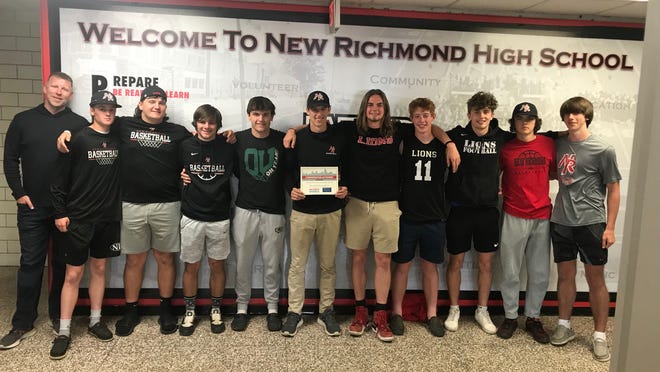
MAYSVILLE, Ky. – The two dogs romp through a fenced-in yard of mud and grass, tails speed-wagging. The brown and white dog pauses only to stand on two feet, front paws on her owner’s shoulders, relentlessly licking the woman's beaming face. Nearby, the black-and-white flops to the ground, rolls to her back and awaits belly rubs.
This is home, for now: A shelter that protects pets of domestic violence survivors.
It’s been four months since the playful mixed-breeds were taken into the small Maysville emergency shelter, the Pet Protection program that offers safety and care and accessibility to the pet's owner – who also lives in a shelter, an escaped survivor of domestic violence.
“We’ve had dogs, cats,” says Bridget Stadtmiller, Pet Protection program director. “And we’ve had two horses!” (These were cared for at a farm.)

The Ion Center for Violence Prevention in Northern Kentucky offers the service to those who leave domestic violence situations. Formerly the Women’s Crisis Shelter, the nonprofit has helped survivors’ pets for years with a patchwork of pet foster care and favors from animal-focused agencies. But 2021 was the first year the agency had its own kennel.
Its 11 spaces are usually full. Often, outside foster care is required to manage additional animals. The program has cared for 45 pets since it opened in March.
The service is imperative – not only for the owners’ well-being but also for the pets’, says Stadtmiller.

"What we’re seeing is animals coming in with some physical injuries, some that need care," she said. Typically, the shelter provides a veterinarian visit, shots, neuter and spay services and an electronic chip as well as food, sleeping quarters and playtime.
Research from the National Coalition Against Domestic Violence supports Stadtmiller's insistence that the animals need sheltering of their own. The coalition found that 85% of survivor shelters commonly encounter women who mention pet abuse. Often, survivors report their batterer had threatened, injured or killed family pets. And most of the abuse happens in the presence of the battered – a tool for revenge or control.
The cost of care at the Maysville shelter is about $500 per pet, generally covered by grants and donations. The average stay for the pets is four to five months, though the shelter had one pet stay for a year-and-a-half.
Stadtmiller started years ago as a volunteer for the violence prevention center and was hired to manage the pet shelter full time. She recently was able to hire a helper, who lives nearby. The new employee’s job includes cleaning and feeding the cats and dogs, but mostly, playing with the animals, Stadtmiller says.
Because play is important to a pet’s well-being, she says.
The pets, Stadtmiller said, deserve the same care their sheltered owners get. An owner needs shelter and food. So does her pet. The owner needs a doctor’s appointment. The pet needs a vet checkup. Exercise? Yes. Comfort? Yes. And every so often, the vet visit reveals a pet's need for a serious issue. A small, calico cat was found to have a tumor while in the shelter. It is awaiting surgery.
Stadtmiller, who fosters animals on her own time, sometimes brings home shelter pets – especially those that exhibit anxiety.

Often, the pets are apprehensive of anyone's touch but their owners.
“I had a dog who, when her owners left, she was scared to death. She was big, and she was still a puppy. For 15 hours, I sat with her myself. I had her at my house. She wouldn’t come out. She was like, ‘My safe person is gone. I’m not coming out of this kennel. You’re not gonna make me.’
“She was right. I didn’t,” Stadtmiller says, laughing. “I stayed up all night with her. I let her see I have other animals. She watched them. They’re letting her know that I was safe. She finally came out.”
The animals sometimes arrive at the kennel with injuries from tangling with their owner’s abuser. “We’ve had two dogs that intervened. They tried to protect the owner. One of them got hurt," Stadtmiller says. It was a 70-pound dog injured by the batterer, she says. The other was uninjured, a 15-year-old, small dog with only four teeth that came to its owner's aide.
On a sunny December morning, the woman visiting her dogs gets on her knees to cuddle them. She lives nearby, so she tries to visit them four times a day, she says. Sometimes, she takes them to a nearby dog park or lets them walk near a river.

Not everyone can take that much time with their pets. The Ion Center's services cover 13 counties in the Northern Kentucky region, so some sheltered owners aren't close to the Maysville pet shelter. They come when they can, Stadtmiller says, and if absent, others tend to the pets' needs.
Even if a pet isn't threatened, it is welcome, Ion Center officials said. The center is open for shelter care 24 hours a day, every day, and people are told they may come with their pets.
“Oftentimes when individuals or families are fleeing abusive homes, a big barrier for them is leaving their pets behind. Many won’t leave if they can’t bring pets,” said Jamie Sivrais, an Ion Center spokeswoman. "So we say to bring them.”

The animals are often the victim's only emotional support, Stadtmiller says. “Especially being isolated in that abusive household, your pet gives you unconditional love and support. If you’re crying, who’s there for you? Your pet comes and comforts you."
Stadtmiller turns to the woman who's playing with her dogs in the enclosed shelter yard.
"What if we didn't have a shelter for them?" she asks, pointing to the two animals.
The woman does not hesitate: “I would’ve slept in my truck."
Source link









